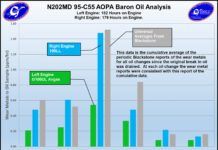There to now with avgas? Following a flurry of activity at EAA AirVenture-briefings and meetings, mainly-has the flag inched forward toward a replacement for 100LL? In short, its hard to tell. If there’s substantive progress, its occurring behind closed doors, although the venue has changed. By early September, the FAA revealed a generally positive test result on a 150- hour test cell run with Swifts UL102 fuel, a variant tof several blends it has developed. Meanwhile, General Aviation Modifications Inc. still has before the FAA a request to approve its G100UL via STC. From what were able to surmise, this effort is stalled, but GAMI says its still pursuing it. Both Swift and GAMI have applied for ASTM International approval of their fuels, which the FAA insists upon before certifying any fuel for general use. Its at this point that things gets complicated, muddied by flyspeck technical considerations that may or may not matter and by politics. Were told that three potential test fuels may go before the ASTM fuels committee in December: Swifts blend, GAMIs G100 and a proposed new fuel called 100ULL (ULL for ultra low lead). The ultra low lead idea percolated up from the GA industry and doesnt have a named sponsor yet. Depending on how the fuel is formulated, it could contain as little as half the tetraethyl lead used in 100LL. The hope is that such a fuel might provide at least an interim step to satisfy proposed EPA rules for reduced emissions, which is whats driving the coming extinction of 100LL. But there are two big unknowns with 100ULL. Will it provide the necessary knock resistance and will EPA go along with an interim lead reduction until it can be eliminated? With no direct sponsor, its also unclear how 100ULL would be tested. In late July in a letter to AOPA at the associations request, EPAs Margo Tsirigotis Oge said the EPA currently had no timeline for lead regulation and that its advanced notice of proposed rulemaking doesnt propose to ban leaded fuels. Nor, she said, does the EPA have the statutory authority to ban lead in fuels. The next day at AirVenture, FAA Administrator Randy Babbitt said exactly the opposite in carefully parsed words that said that only EPA had the statutory authority to regulate lead emissions. (In this context, fuel is merely the vector for the lead.) Optimists might read this as EPA backing off from its threat to extinct avgas by lowering lead emission standards, but the agency still has before it two agenda items that suggest otherwise. The Friends of the Earth/Bluewater Network suit to force EPA to ban lead or conduct lead-limit monitoring is still active. Further, the agencys own agenda calls for sharply reduced lead emissions under its National Ambient Air Quality Standard and it has pushed the states into air monitoring programs. Its unclear if these statements from EPA have stayed the execution or just moved it off. We havent been able to get a clear answer because we think no one knows for sure, given the uncertainty surrounding what EPAs lead monitoring may reveal.

Avgas Tech
On the ASTMs plate is how to develop a standard to approve these new fuels. The consistent barrier in rapid fuels develop has been the industrys insistence that any new fuel meet a specification called ASTM D910. This is sometimes viewed as recipe for how to make unleaded avgas, but thats a misnomer. Its really a specification for purchasing agents buying fuel on contract and although it has limits on some components-such as lead, sulfur and dye, its not a compositional recipe, but rather a description of fuel performance characteristics. If that makes it sound like Shells avgas could be different from Exxons formula, that is exactly the case. But the two will perform the same with regard to octane, heat content and aging.
D910 came about not as a blue sky spec for the perfect avgas but as a real-world description of what was known to work. Unfortunately, because of blind adherence to D910, no proposed new fuel-and dozens have been tested-has passed muster. Into this miasma come Swift and GAMI.
The formula constituents in Swift and GAMI vary substantially from avgas. Swift is a so-called binary composed of 85 percent mesitylene (trimethylbenzene) and 15 percent isopentane. G100UL is composed primarily of conventional aviation alkylate gasoline, blended with a proprietary aromatic package.
Swift easily meets D910s minimum 99.6-octane requirement. The FAAs recent tests pegged it at 102.2 MON, which closely matches what typical FBO avgas really is.
Depending on the blend, G100UL is a little over 98 MON. But GAMIs testing has revealed that there are scale-up effects for some fuels, meaning that 98 MON certified in a single-cylinder octane test engine can provide knock resistance equivalent to more than 100 octane in a full-scale engine. Shell has done research indicating the same thing, suggesting that one way to address this issue is to use a different means of specifying octane for aviation fuels. This is one of the issues the ASTM committee will need to address and resolve.
The FAAs technical report found that Swift fuel meets or is close to D910 on all but two points. Its heat content is lower by 3.7 percent and its distillation end points are quite a bit higher. Distillation end points refer to the percentage of material that evaporates at certain temperatures. Because its composed of a high-boiling point aromatic (mesitylene), Swift fuels limited fractions evaporate at higher temperatures than avgas does. G100UL has similar departures, but theyre not as great.
The over arching question: Does it matter operationally? Our guess is that it probably doesnt, given the amount of flight testing both Swift and GAMI have done thus far. The FAAs 150-hour test cell run on Swift revealed no issues that relate to distillation points, but then the test wasnt designed to do that.
Beyond these technical issues, the larger issue before ASTM is bureaucratic and political. Even though its composed of industry representatives used to making rapid-fire business decisions, ASTM has a reputation for moving at a glacial pace. The committees meet only periodically and their members must fit the work into their day jobs. Further, the committee is composed heavily of oil company representatives who may resist the idea of a patented, compositionally specified fuel, which both Swift and G100UL are.
We were told by two sources involved with the committee that it understands the urgency of accelerating the fuels approval process. Still, the next formal meeting isn’t until December, so progress may not be visible until 2011, if then.




